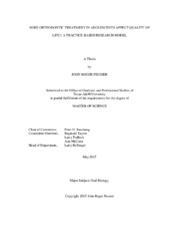| dc.description.abstract | To utilize Baylor’s established practice-based research network (PBRN) to evaluate Oral Health Related Quality of Life (OHRQoL) of orthodontic patients 11-14 years of age.
145 adolescent patients (86 female, 59 male) from 16 private orthodontic practices were surveyed with the Orthodontic Quality of Life Assessment Survey (OQoLAS11-14) at two time-points 6-8 months apart. Participating orthodontists were asked to group patients into three groups based on the stage of treatment: Initial, Middle, and End of treatment groups. Using pretreatment intraoral photographs, pretreatment malocclusion was quantified using the Index of Complexity, Outcome, and Need (ICON). Changes in domain and total OHRQoL scores, as well as associations between OHRQoL and pretreatment malocclusion were evaluated statistically.
Between pre-treatment and 6-8 months into treatment, patients' perceptions of their health and satisfaction of their teeth and mouth improved significantly (p=0.048 and p<0.001, respectively). During this same time period, patients' emotional well-being also improved significantly (p<0.001). During the last 6-8 months of treatment functional limitations (p=0.001), emotional well-being (p=0.022), and social well-being (p=0.005), as well as overall OHRQoL (p<0.001) improved significantly. The end-of-treatment group showed a statistically significant (p=0.047) association (r= -0.316) between their pretreatment malocclusion and changes in the total scores over time.
Adolescent patients' self-reported perceptions of OHRQoL oral health and satisfaction improved significantly during the first 6-8 months after appliance placement. Adolescent patients showed improvements in their emotional well-being during the first 6-8 months of treatment. Functional limitations, emotional well-being, social well-being, and total OHRQoL improved during the last 6-8 months of treatment. | en |


